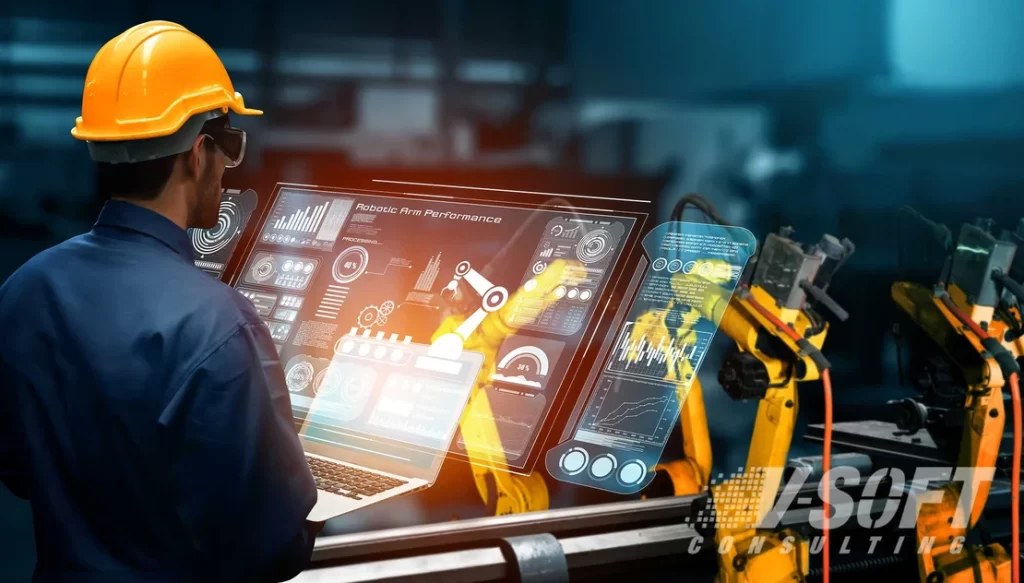Artificial intelligence and predictive maintenance in manufacturing
1. Introduction
Artificial intelligence and predictive maintenance in manufacturing The manufacturing industry relies heavily on the smooth operation of complex machinery and equipment to meet production targets and ensure product quality. However, unexpected breakdowns and equipment failures can result in costly downtime and disruptions to the manufacturing process. Traditional maintenance approaches, such as reactive or preventive maintenance, often fall short in addressing these issues efficiently.https://maninerd.com
2.2 Benefits of Predictive Maintenance
Artificial intelligence and predictive maintenance in manufacturing The adoption of predictive maintenance offers several benefits to manufacturing companies. First and foremost, it helps minimize unplanned downtime by identifying and addressing potential failures in advance. This leads to improved productivity and reduced production losses. Moreover, predictive maintenance optimizes maintenance schedules and resource allocation, resulting in cost savings and increased operational efficiency. Additionally, manufacturers can extend the lifespan of their equipment and reduce the risk of catastrophic failures, leading to enhanced overall equipment effectiveness (OEE).https://seoustad.com
3. The Role of Artificial Intelligence
Artificial intelligence plays a pivotal role in enabling effective predictive maintenance strategies. Here are some key aspects of AI in this context:
3.1 Machine Learning Algorithms
Machine learning algorithms are at the heart of AI-driven predictive maintenance. These algorithms can analyze vast amounts of sensor data and historical records to identify hidden patterns and correlations. By learning from past data, AI models can make accurate predictions about the future behavior of equipment, including potential failures.
3.2 Data Collection and Analysis
To enable predictive maintenance, it is crucial to collect and analyze relevant data. This includes data from sensors, equipment logs, maintenance records, and other sources. AI algorithms can process this data in real-time, identifying abnormalities, trends, and potential failure indicators.
3.4 Condition Monitoring
Continuous condition monitoring is an integral part of AI-based predictive maintenance. Through the use of sensors and IoT devices, manufacturers can gather real-time data on equipment health and performance. AI algorithms can then analyze this data to determine the current condition of the machinery and predict future maintenance requirements.
3.5 Maintenance Optimization
AI can optimize maintenance activities by predicting the most suitable time for maintenance interventions. By considering factors such as equipment utilization, production schedules, and resource availability, AI models can generate optimized maintenance plans. This helps minimize disruptions to production while maximizing the effectiveness of maintenance efforts.
4. Implementing AI-Based Predictive Maintenance
Implementing AI-based predictive maintenance involves several key steps:
Data Collection and Integration
Manufacturers need to establish a robust data collection infrastructure that captures relevant equipment data from various sources. This includes sensors, SCADA systems, ERP systems, and other data repositories. Integration of these data sources is crucial to enable comprehensive analysis and predictive modeling.
4.2 Developing Predictive Models
Once data collection is in place, the next step is to develop AI-based predictive models. This involves training machine learning algorithms using historical data and validating their performance. The models can then be fine-tuned and optimized to provide accurate predictions for specific machinery or equipment.
Real-Time Monitoring and Alerts
Real-time monitoring is essential for proactive maintenance. AI algorithms continuously analyze incoming data streams, comparing them against established patterns and thresholds. When deviations or anomalies are detected, alerts and notifications are generated, enabling maintenance teams to take timely action.
Maintenance Planning and Execution
Based on the insights provided by AI models, manufacturers can plan and execute maintenance activities more effectively. AI can prioritize maintenance tasks, optimize resource allocation, and schedule interventions during planned production downtime. This ensures minimal disruption to operations and maximizes the utilization of maintenance resources.
5. Case Studies
5.1 Automotive Industry
In the automotive industry, AI-based predictive maintenance has revolutionized production lines. By implementing sophisticated machine learning algorithms and IoT sensors, manufacturers can detect equipment failures in advance, reducing downtime and improving productivity. Predictive maintenance has enabled automotive companies to streamline their operations and deliver high-quality vehicles to customers more efficiently.
Pharmaceutical Industry
In the pharmaceutical industry, where strict quality control is paramount, predictive maintenance has gained significant importance. By leveraging AI algorithms and data analytics, pharmaceutical manufacturers can ensure the uninterrupted operation of production lines. Predictive maintenance minimizes the risk of equipment failures that could compromise the quality and integrity of pharmaceutical products, ensuring compliance with regulatory standards.
6. Future Trends and Challenges
6.1 Industry 4.0 Integration
As the manufacturing industry embraces Industry 4.0 principles, the integration of AI-based predictive maintenance will become more prevalent. The seamless connectivity between machines, data systems, and AI models will enable real-time decision-making and predictive capabilities, further enhancing operational efficiency.
6.2 Data Security and Privacy
With the increasing reliance on AI and data-driven technologies, ensuring the security and privacy of manufacturing data becomes paramount. Robust cybersecurity measures must be implemented to safeguard sensitive information and protect against potential threats or breaches.
6.3 Workforce Training and Skill Development
The implementation of AI-based predictive maintenance requires a skilled workforce capable of operating and maintaining the AI systems. Manufacturers need to invest in training programs to equip their employees with the necessary knowledge and skills to effectively leverage AI technologies.

